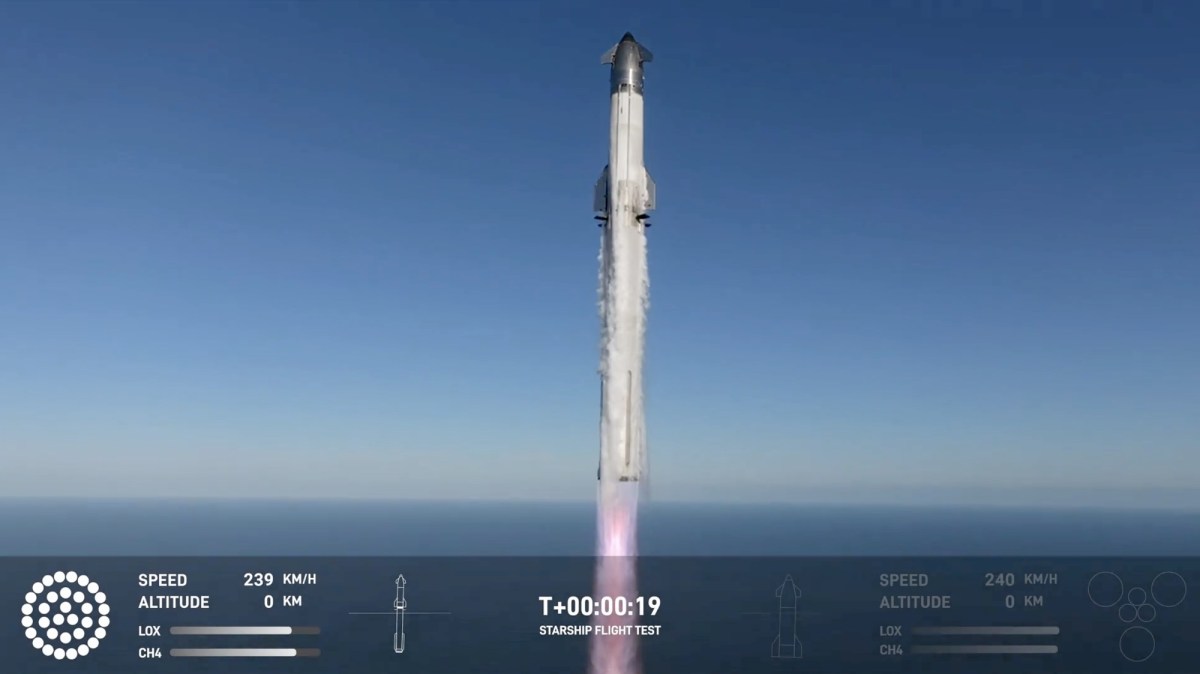Updated 9:05 p.m. Eastern with comments from FAA and Elon Musk.
WASHINGTON — SpaceX’s seventh Starship/Super Heavy test flight ended prematurely Jan. 16 when the Starship upper stage was apparently lost while ascending into space.
The vehicle lifted off from SpaceX’s Starbase test site at Boca Chica, Texas, at 5:37 p.m. Eastern. The Super Heavy booster ignited its 33 Raptor engines, sending the vehicle into clear skies.
The booster separated about two minutes and 45 seconds after liftoff and headed back towards Starbase. It returned to the launch pad where “chopstick” mechanical arms attached to the sides of the tower caught the booster seven minutes after liftoff, repeating a feat first performed on the vehicle’s fifth flight in October.
The Super Heavy booster returns to the launch site to be caught by mechanical arms on the launch tower. Credit: SpaceXWhile the booster returned, Starship continued to ascend. However, onscreen telemetry showed one of the six Raptor engines on Starship shut down seven minutes and 40 seconds after liftoff, followed by two more engines roughly 20 seconds later. By eight minutes and 25 seconds after liftoff only one Raptor engine was firing, according to the display, and the vehicle’s speed and altitude were no longer updating.
“We had an anomaly with that upper stage,” Dan Huot, one of the hosts of the SpaceX webcast of the launch, said minutes later. “At this point, we are assuming that the ship has been lost.” SpaceX confirmed minutes later that the vehicle had been lost. Video soon appeared on social media showing what may be debris from the vehicle burning up and falling over the Turks and Caicos.
A number of aircraft flying in the vicinity at the time of Starship’s breakup were instructed by flight controllers to go into holding patterns or, in some cases, diverted to other airports to avoid any risk of being struck by falling debris.
“The FAA briefly slowed and diverted aircraft around the area where space vehicle debris was falling,” the Federal Aviation Administration said in a statement. “A Debris Response Area is activated only if the space vehicle experiences an anomaly with debris falling outside of the identified closed aircraft hazard areas.”
The flight was the first of a “block upgrade” for the Starship upper stage. That includes stretching the vehicle by about two meters to a length of 52 meters, accommodating larger propellant tanks that carry 25% more propellant. The vehicle features a “complete redesign” of its avionics with new computers, antennas and power distribution system as well as changes to the forward flaps to reduce heating.
Other changes involve the vehicle’s thermal protection system, with new tiles and a layer underneath that will provide protection in the event of damaged or missing tiles. Some tiles were deliberately removed to stress-test vulnerable areas, while the vehicle intended to some metallic tile options, some incorporating water cooling. Those and other changes are designed to prepare for future flights where SpaceX will attempt to land the Starship upper stage back at the launch site.
SpaceX had planned to perform a Raptor engine relight of Starship while in space and also deploy 10 mass simulators of “V3” versions of Starlink satellites optimized for Starship.
“Preliminary indication is that we had an oxygen/fuel leak in the cavity above the ship engine firewall that was large enough to build pressure in excess of the vent capacity,” SpaceX Chief Executive Elon Musk posted on X, the social media site he also owns. “Apart from obviously double-checking for leaks, we will add fire suppression to that volume and probably increase vent area. Nothing so far suggests pushing next launch past next month.”
That schedule may be overoptimistic. The loss of Starship will likely lead to the FAA mandating a mishap investigation before allowing SpaceX to resume Starship launches. That could delay the next launch by months even though SpaceX has been rapidly producing hardware for future Starship vehicles as the company seeks to scale up launch rates.
SpaceX was planning to soon launch Starships into orbit, rather than on suborbital test flights like this mission. Those future missions would include an in-space propellant transfer demonstration that is a key milestone for development of the Starship lunar lander SpaceX is developing for NASA’s Artemis lunar exploration campaign.
